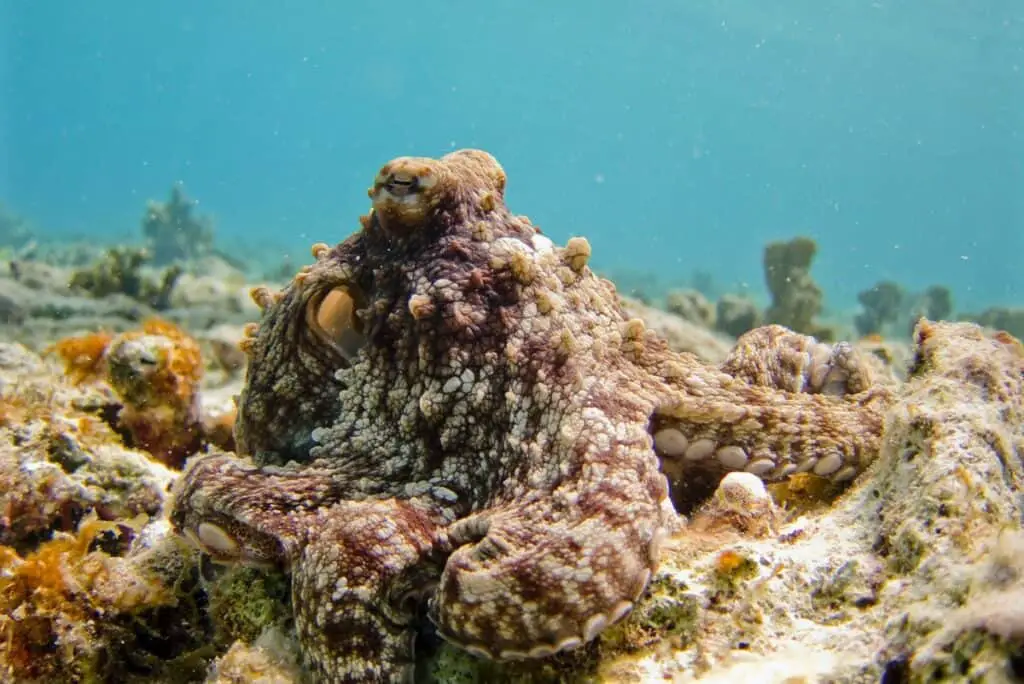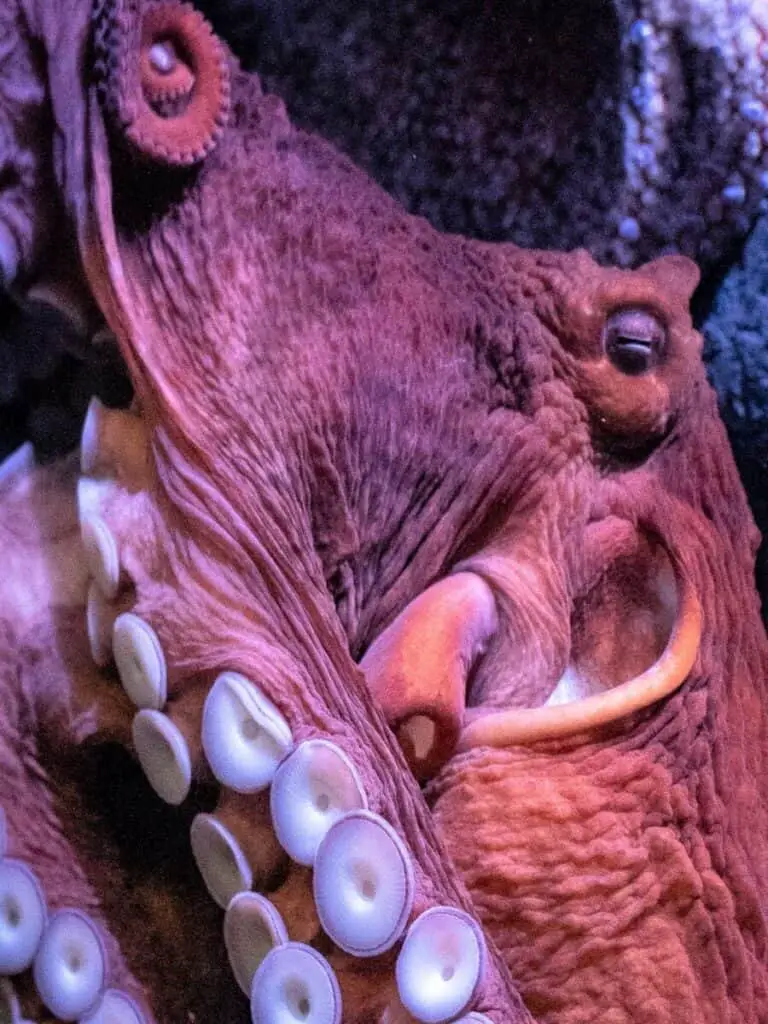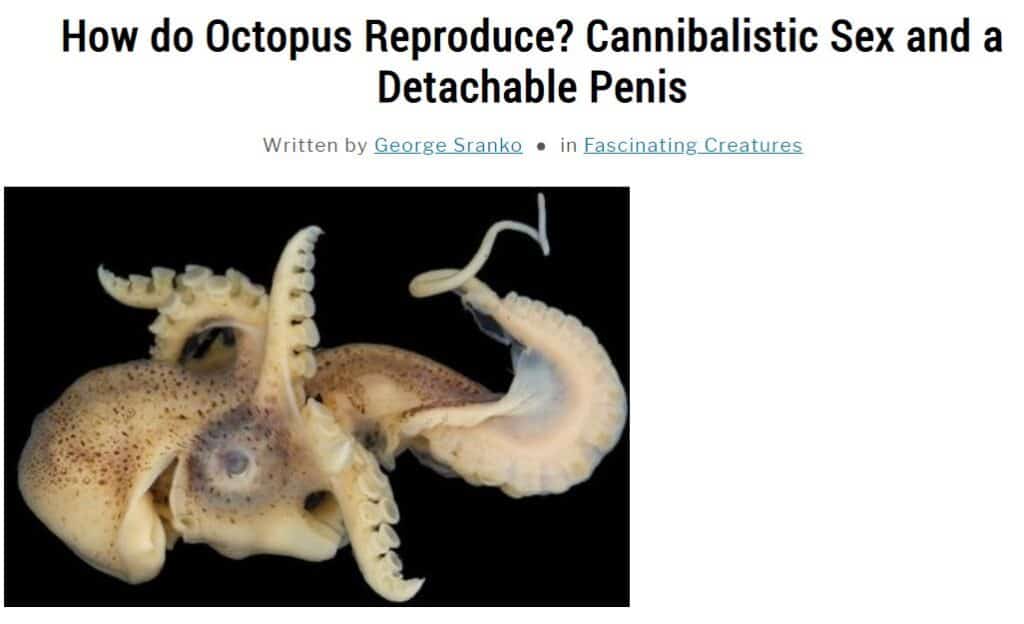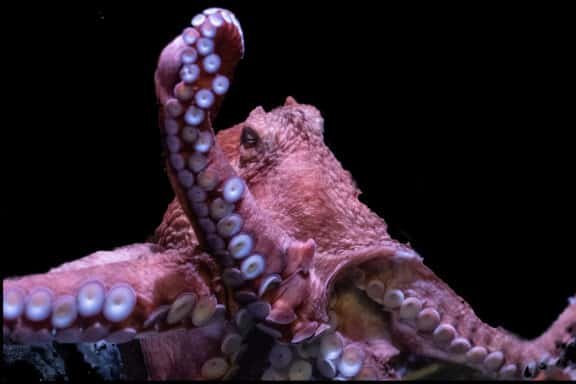Learning about fascinating creatures is a passion of mine, and one of the most amazing creatures I’ve run across is the octopus. The description in the title above says it all – these animals are REALLY INTERESTING!! Be prepared to have your mind stretched in eight different directions!
Octopuses have 9 brains because, in addition to the central brain, each of 8 arms has a mini-brain that allows it to act independently, and to explore more efficiently with their arms. Octopuses have 3 hearts, because two pump blood to the gills and a third, larger heart circulates blood to the rest of the body. Octopuses have blue blood because they have adapted to cold, low oxygen water by using hemocyanin, a copper-rich protein.
Why Do Octopuses Have 9 Brains?
Octopuses have 9 brains because this configuration enables them to use their arms more swiftly and efficiently.
They can explore for food with remarkable efficiency since each arm has the ability to act autonomously, tasting, touching, and moving without guidance from the central brain. This means that more than one arm can be exploring and feeling around at the same time, “doing its own thing.”
However, the central brain does have the capacity to impose top-down control when necessary.
We know that octopuses are intelligent, because they like to play and use tools – but we have no way of relating to what it would be like to have 9 brains.
The central brain is a doughnut shape that forms a ring around the esophagus, so when an octopus swallows, its food must ‘pass through’ the brain! What a concept! Food for thought…?
One of the most interesting things about octopuses is that they have a mini brain in each arm. This adds up to a lot of distributed brain power. In fact, most of the neurons are in the arms. This means that the arms can taste, touch, and move autonomously without micro-management by the central brain.
Since each arm has a mini brain, the central brain just sends a higher-level signal to the arm; something like “move to crevice for possible crab.”
In our case, our brain would guide and control each movement of our arm. With an octopus, the arm acts almost independently as it proceeds to probe into the crevice, tasting and feeling with its suckers.

Multiply this by 8 for eight arms and we can see that the mini brains take a big load off the central brain. Each arm is controlled by a complex nervous system made up of more than 40 million neurons that are linked to the suckers, chromatophores, chemical sensors, etc. of the octopus.
Researchers have found that 180 million neurons in the central brain are connected to more than 40 million neurons in each of the eight arms.
This adds up to 500 million neurons in total, a number that is roughly equivalent to that of several mammals, including dogs. That’s two and a half times as many as a rat.
Cephalopods, including octopuses, have the largest nervous systems of any invertebrate.
Their nervous system, which evolved independently from vertebrates, is nothing short of amazing. As if their cunning and dexterity weren’t enough, octopuses have chemoreceptors on their suckers that allow them to detect chemicals in their environment. This enables them to better “taste” potential food sources by essentially turning their suckers into chemical sponges.
As a testament to their powers of perception, octopuses have more neurons than any other invertebrate. This elevated neural capacity translates into some serious problem-solving prowess, helping them hone their skills and excel in the hunt for food.
Beyond their ability to sense chemical signals, octopuses have fine motor skills that allow them to apply various strategies when searching for food or trying to extract something tasty from a seemingly impenetrable container. These fascinating cephalopods truly have what it takes to stand out in the marine world!
Octopuses Are So Brainy They Can Use Tools!
Did you know that octopuses use their problem-solving skills to create makeshift tools? It’s true! Some species have been known to use coconut shells as portable shelters, showcasing their resourcefulness in their natural habitats. As you can see, their remarkable dexterity and problem-solving abilities aren’t just limited to artificial puzzles or man-made objects.
We know octopuses are brainy – but how smart are they? Read my in-depth article to find out! (Hint: your average dog has only one brain!)
Fun Fact! If an octopus loses an arm, it can regenerate a perfectly functioning replacement – complete with a new mini-brain – in 100 days! Read how – click here!
For something different check out my article on the Koala’s brain – a mammal that has lost brainpower through natural selection – Why it Can Pay to be Dumb!
What Role Does the Central Brain Play in an Octopus?
Having its own mini-brain, each arm of an octopus can move, taste, and touch somewhat independently from the central brain. This opens more potential opportunities for exploration.
But what about the central brain?
The central brain issues top-down commands to its “staff” of mini-brains, as if each arm with its own mini-brain was a soldier dispatched to perform a separate duty.
In 2011, scientists conducted an experiment to see if the brain possesses centralized, top-down control over the limbs. They created a transparent maze that made the octopus reach out of the water and around to get hold of some food. By leaving the water, the arm would lose feedback from its chemical sensors. The octopus would then have to rely on visual cues to direct its arm.

Most of the octopuses passed the test, showing that they do indeed have central, top-down control of each arm if it is required. (Gutnick et al. 2011)
Perhaps the central brain acts like the conductor of an orchestra!
Evolution and Comparison With Vertebrate Brains
While comparing the octopus’s nervous system to ours may seem like comparing apples and oranges, there are some interesting similarities and differences worth noting. Octopuses, being invertebrates, have a decentralized nervous system compared to vertebrates like us. In fact, their nervous system has two major parts: a central brain and nerve cords extending through each arm.
Neurons in the octopus function much like the ones in your body, transmitting electrical signals between the brain, skin, organs, glands, and muscles. This complex network allows them to communicate with their environment and perform impressive feats.
It’s important to understand that the evolution of the octopus nervous system happened independently from vertebrates.
This is an amazing example of convergent evolution, where different organisms develop similar traits due to similar environmental pressures. In the case of octopuses, the need for a sophisticated nervous system likely arose from their predatory lifestyle and the need to efficiently navigate and hunt in their environment.
Check out my new book “The Octopus Paradox” – full of fascinating information on these amazing creatures. What is the paradox?
Keep an Eye on Your Arms to Find Some Food
One strange thing is that an octopus doesn’t know exactly where its arm is unless it can see it.
The arm is sending signals about taste and texture back to the central brain, but no data about location and orientation. In our bodies we have an ability called proprioception that lets us know where our arms are even if they are out of sight. We can scratch our backs with precision because we know where our hand is relative to our back.

Octopuses have not ‘missed-out’ on acquiring this useful ability. They are not able to pinpoint the exact location of each arm for a good reason! Without any bones or joints in its body, an octopus is changing its shape moment by moment as it moves around. We humans carry a fixed “map” of our body in our brain, but that would be impossible for an octopus, since their body shape is so fluid and constantly changing.
Watch the Octopus Disappear! Camouflage Colors and Textures
Octopuses have what could be considered “thinking skin” directly connected to the central nervous system.
Not only does the central brain control the mini-brains within each arm, it connects directly to potentially millions of pigment sacs in the skin, depending on the species.
The lower brain’s nerves have a direct connection to the muscles that surround the pigment sacs, or chromatophores, according to anatomical evidence.
Chromatophores are tiny, pigmented cells that are found in the skin of octopuses. These cells can change color and shape, allowing the octopus to rapidly alter its appearance. For example, if an octopus is swimming over a patch of sand, it may use its chromatophores to turn a light beige color to blend in with the sand. Alternatively, if it’s swimming over a bed of colorful coral, it may use its chromatophores to turn a bright pink or purple color to match the coral
When the muscles are contracted, the sacs are pulled apart, distributing the chromatophore pigments into thin discs of color like an artist spreading paint on a palette.
But the real magic happens when the octopus combines its chromatophores with other skin features, like papillae and iridophores. Papillae are small, muscular bumps on the skin that can be raised or lowered to create texture, while iridophores are cells that can reflect light to create shimmering patterns on the skin. By combining these features with their chromatophores, octopuses can create incredibly intricate and realistic patterns on their skin, making it nearly impossible to spot them.
Watch an Octopus Disappear Like Magic!
One of the most amazing demonstrations of octopus camouflage that I’ve seen was filmed by Professor Roger Hanlon, University of Chicago. It shows a seaweed covered boulder turn into an octopus – like magic! And then he reverses the video and you can see the octopus become one with the seaweed and the boulder. Look at the video below to see for yourself.
In this video, not only does the animal acquire the colors of the background seaweed and boulder, but it changes the texture of its skin to match. There are millions of pigment cells or chromatophores in the skin and millions more of the nerve endings needed to create the skin texture.
And it all happens in the blink of an eye. This is because the chromatophores are controlled by muscles and nerves, allowing the octopus to rapidly change its appearance to match its surroundings.
Camouflage is another reason octopuses have evolved such complex nervous systems.
How Do Octopuses Keep Their Suckers from Sticking to Each Other?
Another interesting question about having eight arms covered with suckers – how do they keep all those arms from sticking to each other and getting all tied up in knots? Especially when they don’t know exactly where their arms are.
Turns out that octopus skin secretes a chemical to keep the suckers from sticking to it. Sounds essential for avoiding a tangled mess!
Octopus Sex and the Thrill of Surviving
Talking about arms let’s touch on sex! Yes, there is one arm that plays an important role in octopus sex. It is called the hectocotylus (try to spell that with your eyes closed!).
The hectocotylus is a specially adapted arm that the male octopus uses to pass his sperm to a receptive female. Octopus sex deserves an entire article of its own (which I have written! see How do Octopuses Mate? Cannibalistic Sex! How does a Detachable Penis Work?) Check it out!

In this article I get into the nitty gritty… did you know that a male octopus can have an erection? Sounds like a good conversation starter, doesn’t it?!!
The gist is that when a male and female octopus mate, the male reaches over with his specialized arm and delicately deposits one or two packets of sperm underneath the female’s mantle. And then he backs off quickly. He needs a long arm for this special delivery because the female can become cannibalistic as soon as she receives his love-packet. Now that she has his sperm the male is only good for one thing – nourishment!!

Cannibalism makes good sense from the female’s perspective, since she will need to be well-nourished to produce thousands of eggs and to spend months looking after them without feeding. Each female lays up to 100,000 fertilized eggs in clusters under an overhang. In most species the females constantly guard, clean and oxygenate the eggs for up to seven months before the young hatch. The mothers never feed during this period and can lose more than 50 percent of their body weight before the young hatch. In most species the females die shortly afterwards.
Sex is bad for the health of the males, as well. Once they’ve mated the males begin to decline rapidly as they enter a period of senescence. They stop eating and begin acting erratically, until they die shortly afterwards.
Why Would You Need 3 Hearts?
An octopus might ask, how can humans manage with just one heart?
Many of the octopus species live deep in the oceans where there is less oxygen available and the water is frigid. Given this environment, octopuses have evolved three hearts to help get sufficient oxygenated blood to all parts of the body, even to the tips of the arms. Two hearts pump blood to the gills and a larger heart takes the oxygenated blood and circulates it to the organs and the rest of the body.
In some species, the larger heart stops beating when the animal swims. I guess it better not swim for too long!
I have a complete article that dives deep into the wonders of octopus hearts.
True Blue Bloods have a Thing for Copper
Since many octopus live in cold deep waters, they’ve adapted by using a copper-rich protein called hemocyanin to oxygenate their blood rather than our iron-rich hemoglobin. This gives a blue tint to their blood, while hemoglobin turns our blood red.
Because their copper-based blood is not an efficient oxygen carrier, octopuses favor cooler oxygen-rich water.
Octopuses are Not Here for a Long Time – Hope it’s a Good Time!
It is surprising that octopuses have so many amazing abilities going for them and yet their lifespan is short – only three to five years.
If they lived for as many years as we humans do, they would probably be running the planet by now! Because of their life-cycle they lack one of the characteristics that we consider important for an advanced species. Octopuses don’t care for their young, so there is no inter-generational learning.
This means that each individual octopus must discover and learn everything that it needs to know to survive on its own.
Imagine that! No parents around to tell the youngsters how to behave. For some human teens this might seem like a dream come true! But for a species as a whole, it results in major limitations. Not being able to pass on the wisdom gained by previous generations means a whole lot of learning gets repeated and rediscovered by each succeeding generation.
Congratulations! You must be pretty keen on octopuses to read this far! Are you certain you only have one brain?!
Another Amazing Octopus Ability – Regenerating Lost Appendages!
The octopus is one of the few creatures that can regrow a completely severed or damaged appendage so that it is as GOOD as new and indistinguishable from the original. A missing arm can be completely regenerated in roughly 100 days.
In the case of the octopus, this means regenerating an entire mini brain from scratch! To find out more about this amazing ability take a look at my article on Octopus Regeneration.

Fun Facts and Not-so-Fun Facts
- Octopuses grow quickly, gaining up to 2 percent of their body weight a day. This is based on a remarkable 50% efficiency in converting food energy into mechanical output. Humans are only half as efficient at 25%. (Thank goodness I say! Imagine 50% of every doughnut going straight to your waist!)
- Octopuses have over 2,000 suckers. Each sucker operates independently and features chemo-receptors that can taste everything they touch. (Which can be kind of icky if you think about it!)
- They kill their prey by thrusting their sharp tongue, much like a small rasp or file, into the victim and injecting venomous saliva.
- After hatching, octopuses live as tiny paralarvae drifting around in clouds of plankton near the ocean surface.

- Octopus paralarvae feed on the abundant zooplankton — but life in the plankton layer is perilous – they take a turn at becoming food for the billions of other creatures that feed on plankton.
- Biologists estimate that out of 50,000 to 75,000 eggs laid, only 2 will survive to become mature adults.
- Octopuses are highly intelligent, somewhat comparable to your pet cat or dog. Their abilities in navigating mazes and their problem-solving skills show that they have both short and long-term memory.
Don’t forget to check out my article on fascinating facts about octopus sex – including a detachable p…(er… male member) (Can male octopuses have an erection? Find out!)
Can an Octopus Kill You? One Word – Sannakji
Imagine trying to eat a live octopus, with the arms still squirming on the plate.
The Korean dish Sannakji features live baby octopus arms cut into pieces and served fresh and mobile.
Those of us who know that each arm has a mini-brain of its own might think twice about trying to swallow a live octopus arm. Even when an arm is severed from its body, the suckers will keep applying suction. This means that arms must be well chewed before swallowing, otherwise they will stick to the mouth and throat.

Apparently, an average of six people choke and die from wrapping their mouths around sannakji each year.
Yes, a live octopus can kill you, especially if you are dumb enough to stick one into your mouth.
Oh, yes… in fact there is an octopus that can kill you if you step on one by accident. The venom contains a powerful neurotoxin called tetrodotoxin, which can cause paralysis and respiratory failure. There is no antivenom for this venom, and if left untreated, the bite can be fatal.
Do you find octopuses fascinating? You might like my new book “The Octopus Paradox” – full of facts to impress your friends and family.
Want to know more about octopuses?
Check out my series of articles on these fascinating creatures:
How do Octopus Reproduce? (Cannibalistic Sex and a Detachable Penis)
How Smart are Octopuses? (Are Octopuses As Intelligent as Dogs?)
How Do Octopus Kill Their Prey? Can an Octopus Sting You? (Beaks and Venom)
Why do Male Octopuses Die after Mating? (How does Octopus Senescence work?)
Can Octopus Arms Grow Back? (Are Regenerated Limbs Just as Good?)
Why Do Octopuses Have 3 Hearts and Blue Blood? Secrets of an Open Circulatory System
Check out these Octopus Gifts for the Octopus Lover in your Life
Octopus fans love to wrap their arms around Octopus gifts and Octopus books. It doesn’t take 9 brains to realize that octopuses are some of the coolest creatures on the planet!
Resources
Monterey bay aquarium provides an excellent series of octopus videos that I can highly recommend.
CephBase: The comprehensive website at CephBase is an authoritative source of data and factual information for the CLASS CEPHALOPODA – squids, octopuses, cuttlefish and nautilus.
References
Gutnick, Tamar et al. Octopus vulgaris Uses Visual Information to Determine the Location of Its Arm. Current Biology, Vol. 21, No. 6, pages 460–462; March 22, 2011.
Hochner, B. et al., The octopus: a model for a comparative analysis of the evolution of learning and memory mechanisms, Biol Bull., 210:308-317, 2006.
Zullo, L., Eichenstein, H., Maiole, F. et al. Motor control pathways in the nervous system of Octopus vulgaris arm. J Comp Physiol A 205, 271–279 (2019). https://doi.org/10.1007/s00359-019-01332-6
See Our TOP Articles for Even More Fascinating Creatures
- How do Octopus Reproduce? (Cannibalistic Sex, Detachable Penis)
- How Smart are Octopuses? Are Octopuses As Intelligent as Dogs?
- How do Electric Eels Shock Their Prey? Can an Electric Eel Kill You?
- Do Jellyfish have Brains? How Can they Hunt without Brains?
- Why are Deep Sea Fish So Weird and Ugly? Warning: Scary Pictures!
- Are Komodo Dragons Dangerous? Where Can you See Them?
- Koala Brains – Why Being Dumb Can Be Smart (Natural Selection)
- Why do Lions Have Manes? (Do Dark Manes Mean More Sex?)
- How Do Lions Communicate? (Why Do Lions Roar?)
- How Dangerous are Stonefish? Can You Die if You Step on One?
- What Do Animals Do When They Hibernate? How do they Survive?
- Leaf Cutter Ants – Surprising Facts and Adaptations; Pictures and Videos
- Irukandji Jellyfish Facts and Adaptations; Can They Kill You? Are they spreading?
- How to See MORE Wildlife in the Amazon: 10 Practical Tips
- Is it Safe to go on Safari with Africa’s Top Predators and Most Dangerous Animals?
- What to Do if You Encounter a Bullet Ant? World’s Most Painful Stinging Insect!
- How Do Anglerfish Mate? Endless Sex or Die Trying!
- How Smart are Crocodiles? Can They Cooperate, Communicate…Use Tools?
- How Can We Save Our Oceans? With Marine Sanctuaries!
- Why Are Male Birds More Colorful? Ins and Outs of Sexual Selection Made Easy!
- Why is the Cassowary the Most Dangerous Bird in the World? 10 Facts
- How Do African Elephants Create Their Own Habitat?
- What is Killing Our Resident Orcas? Endangered Killer Whales
- Why are Animals of the Galapagos Islands Unique?
- Where Can You See Wild Lemurs in Madagascar? One of the Best Places
- Where Can You see Lyrebirds in the Wild? the Blue Mountains, Australia
- Keeping Mason Bees as Pets
- Why do Flamingos have Bent Beaks and Feed Upside Down?
- Why are Hippos Dangerous? (Do They Attack People?)


